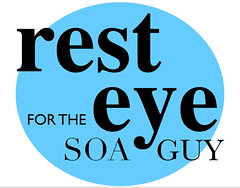There has been quite a bit of chatter in the blogosphere from Library Journal's recent decision to hire the Annoyed Librarian.
After returning to my hotel room after dinner last night (in Cinci attending the LITA Forum) I had a message awaiting on the hotel phone with the following message:
"There is a very important matter I need to discuss with you. Please meet me in the southeast corner of the lower level of the Mall parking garage across from the hotel at 2 am. I know the identity of the Annoyed Librarian."
After a long night, I may now know the identity of the Annoyed Librarian. And no, it isn't
Meredith Farkas.
I left my 11th floor hotel room at around 1:45am, sneaking down the back stairs to alley. I then walked through the shadows and around the dumpsters of the alleyway, making my across the street over into the garage, looking back often making sure I wasn't being followed.
When I arrived to the lower level nobody was there. Fifteen minutes passed, and then a half hour. Then out of the corner of my eye I caught a faint glow. There he was, waiting in a dark corner, huddled against the wall.
" So, you want to know who the Annoyed Librarian is?"
"Well, it could help me to increase the profile of my blog," I said as I took out me phone to update my Facebook status," Why are you wanting to tell me?"
It was obvious that knowing the identify of the Annoyed Blogger had taken its toll. Even when he was in the shadows of the garage I could tell was quite thin and, when the end of his cigarette glowed when he drew on it, his eyes were quite bloodshot.
The man I began to think of as Deep Link then began to sip the drink he had gingerly, then wiped his mouth inelegantly with the back of his hand.
"He ran the blog. Insulating himself through the functionaries around him. This guy is smart and can be smooth if necessary. "
"Wait a second, he?! I thought the Annoyed one was a she! How worried was he that the fact that she was a he would be found out?"
"How worried was he? Worried?" Deep Link began pacing around nervously, his lower jaw seemed to quiver. "The covert activities at LJ involves everybody and are incredible. The cover up has little to do with the blog itself. It is all a publicity stunt thought up by LJ and the Annoyed Librarian."
He walked forward towards me and in front of one of the cars in the garage and, standing erect, placed his gloved hands authoritatively on the hood as if it were a rostrum. Deep Link then confirmed what all the bloggers had missed.
"You mean the past ALA President that has been called antidigital, elitist, and a luddite by his detractors?"
"Think about it." Deep Link said pulling out copies of posts and looking at them like a dealer studying his hand.
"All the posts about ALA politics and even a mention of him sending
fan mail. There was even several
attempts to divert any attention away from himself. In fact, if you noticed, the Annoyed Librarian blog started near the end of his term as President. The Annoyed Librarian is his alter ego. Do you think he really retired?"
Deep Link then went on to talk about how politics had infiltrated every corner of LJ, a strong arm takeover, and the frightening implications on how far LJ would go to meet their ends. The involvement of at least 50 undercover LJ operatives.
So what we may be looking at can only be described as
GormanGate.
As daylight began to break we parted ways. I sought out the closest
LillyPad site to work on this post....
So that is what I know. Please feel to comment if you have other evidence which can help confirm this information.
(thanks to Woodward and Bernstein for the inspiration and an occasional description. EDIT: Sorry Bob! Spellcheck initially changed your name...)
Sphere: Related Content


 The first Google (Android) phone will be release by T-Mobile on October 22nd.
The first Google (Android) phone will be release by T-Mobile on October 22nd.
 A cottage industry began with companies such as Spry releasing their versions of Mosaic buddled with Internet services.
A cottage industry began with companies such as Spry releasing their versions of Mosaic buddled with Internet services. 
 I am still trying to get a grasp of the concept, but essentially, the idea is that when quantified and graphed human activity creates a common and predictable 'wave' pattern. The trend line moves up or down the graph with the primary trend impulsively. These impulsive (dramatic) moves come in stair-step fashion, five waves at a time. Waves 1, 3, and 5 progress and waves 2 and 4 regress (or correct).
I am still trying to get a grasp of the concept, but essentially, the idea is that when quantified and graphed human activity creates a common and predictable 'wave' pattern. The trend line moves up or down the graph with the primary trend impulsively. These impulsive (dramatic) moves come in stair-step fashion, five waves at a time. Waves 1, 3, and 5 progress and waves 2 and 4 regress (or correct). Citysearch and Antenna Audio
Citysearch and Antenna Audio




